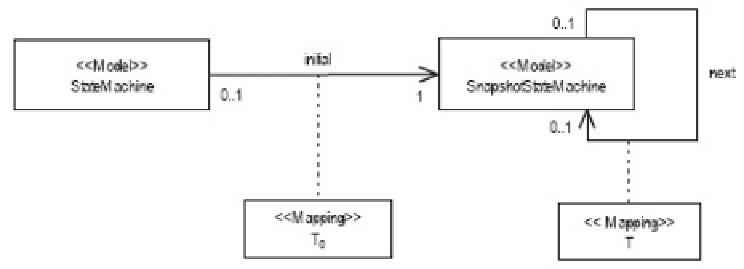Database Reference
In-Depth Information
Figure 7: Relationships between models and mappings
tion of the concept. Given two class diagrams
C
and
C'
at the Metamodel Level, we defi ne
a map from
C
to
C'
a model of
C
. In our particular case, the maps
TTT
and
T
that we have informally described
C
to
C C'
as a method which allows a model of
C'
to be determined starting from
T
above have to be defi ned. More specifi cally,
TTT
has to be a map from the Base Diagram to
the Snapshot Diagram and
T
has to be a map from the Snapshot Diagram to itself.
T
The specifi cation of each map contains, fi rstly, its signature, which specifi es the name
of the map, its parameters and the specifi cation of the result that is obtained after the applica-
tion of the map. One of the parameters determines the model that will be modifi ed, and the
rest determine the specifi c information that each map needs to know in order to accomplish
its effect. In addition, a schematic algorithm of the map is given. We are going to comment
on those aspects we consider important in relation to
TTT
and
T
maps.
T
has to be a map from the Snapshot Diagram to itself.
T
The setting-up of the initial status of a state machine is modeled in our metamodel by
means of the application of map
TTT
(see Table 1), that starting from a basic state machine
M
leads to a snapshot state machine
MMM
D
.
T
maps.
D
.
D
Map
TTT
does not include in
MMM
D
any information about
the history of the state machine since it represents the fi rst status. As for the initial active
state confi guration, this is obtained calculating the default state confi guration of the top state,
by means of the
stateConfi guration
operation of the
State
class (see Figure 6 and Table 1).
Map
TTT
should be specifi ed with a higher degree of detail, probably using a refi nement of
the map, but we have not analyzed it here for space reasons (note that in OMG (2003) this
matter is not studied in detail either).
The run-to-completion step is modeled through the map
T
that results in a snapshot
T
state machine
M'
D
M'
D
M'
starting from another
MMM .
An accurate description of a run-to-completion
step is a very complex task, which is likely to be unapproachable all at once. We have been
inspired by the algorithmic description of step in Harel and Naamad (1996), where three
subtasks (in turn non-trivial) are specifi ed to defi ne a step. This idea has led us to consider
a two-stage refi nement of the map
T
. These stages are represented in the metamodel by
T
means of two additional class diagrams (Figures 8 and 9), in which we have used the same
graphical notation previously explained (so that the elements of each class diagram that
remain unchanged with respect to the previous one are depicted using discontinuous lines).
As a consequence of the specifi cation of both class diagrams, three intermediate maps,
TTT
,




















